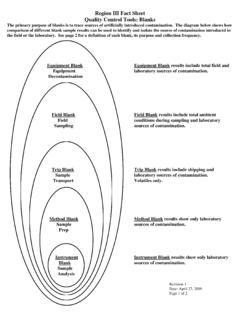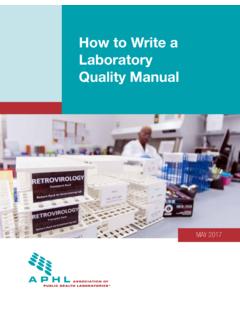Transcription of Q 2 (R1) Validation of Analytical Procedures: Text and ...
1 European Medicines Agency June 1995. CPMP/ICH/381/95. ICH Topic Q 2 (R1). Validation of Analytical Procedures: Text and Methodology Step 5. NOTE FOR GUIDANCE ON Validation . OF Analytical PROCEDURES: TEXT AND METHODOLOGY. (CPMP/ICH/381/95). APPROVAL BY CPMP November 1994. DATE FOR COMING INTO OPERATION June 1995. 7 Westferry Circus, Canary Wharf, London, E14 4HB, UK. Tel. (44-20) 74 18 85 75 Fax (44-20) 75 23 70 40. E-mail: EMEA 2006 Reproduction and/or distribution of this document is authorised for non commercial purposes only provided the EMEA is acknowledged PART I: Validation OF Analytical PRROCEDURES: DEFINITIONS AND METHODOLOGY. ICH Harmonised Tripartite Guideline 1.
2 INTRODUCTION. This document presents a discussion of the characteristics for consideration during the Validation of the Analytical procedures included as part of registration applications submitted within the EC, Japan and USA. This document does not necessarily seek to cover the testing that may be required for registration in, or export to, other areas of the world. Furthermore, this text presentation serves as a collection of terms, and their definitions, and is not intended to provide direction on how to accomplish Validation . These terms and definitions are meant to bridge the differences that often exist between various compendia and regulators of the EC, Japan and USA.
3 The objective of Validation of an Analytical procedure is to demonstrate that it is suitable for its intended purpose. A tabular summation of the characteristics applicable to identification, control of impurities and assay procedures is included. Other Analytical procedures may be considered in future additions to this document. 2. TYPES OF Analytical PROCEDURES TO BE VALIDATED. The discussion of the Validation of Analytical procedures is directed to the four most common types of Analytical procedures: Identification tests. Quantitative tests for impurities' content. Limit tests for the control of impurities. Quantitative tests of the active moiety in samples of drug substance or drug product or other selected component(s) in the drug product.
4 Although there are many other Analytical procedures, such as dissolution testing for drug products or particle size determination for drug substance, these have not been addressed in the initial text on Validation of Analytical procedures. Validation of these additional Analytical procedures is equally important to those listed herein and may be addressed in subsequent documents. A brief description of the types of tests considered in this document is provided below. Identification tests are intended to ensure the identity of an analyte in a sample. This is normally achieved by comparison of a property of the sample ( , spectrum, chromatographic behavior, chemical reactivity, etc) to that of a reference standard.
5 Testing for impurities can be either a quantitative test or a limit test for the impurity in a sample. Either test is intended to accurately reflect the purity characteristics of the sample. Different Validation characteristics are required for a quantitative test than for a limit test. Assay procedures are intended to measure the analyte present in a given sample. In the context of this document, the assay represents a quantitative measurement of the major component(s) in the drug substance. For the drug product, similar Validation EMEA 2006 2. characteristics also apply when assaying for the active or other selected component(s). The same Validation characteristics may also apply to assays associated with other Analytical procedures ( , dissolution).
6 The objective of the Analytical procedure should be clearly understood since this will govern the Validation characteristics which need to be evaluated. Typical Validation characteristics which should be considered are listed below: Accuracy Precision Repeatability Intermediate Precision Specificity Detection Limit Quantitation Limit Linearity Range Each of these Validation characteristics is defined in the attached Glossary. The table lists those Validation characteristics regarded as the most important for the Validation of different types of Analytical procedures. This list should be considered typical for the Analytical procedures cited but occasional exceptions should be dealt with on a case-by-case basis.
7 It should be noted that robustness is not listed in the table but should be considered at an appropriate stage in the development of the Analytical procedure. Furthermore revalidation may be necessary in the following circumstances: changes in the synthesis of the drug substance;. changes in the composition of the finished product;. changes in the Analytical procedure;. The degree of revalidation required depends on the nature of the changes. Certain other changes may require Validation as well. EMEA 2006 3. TABLE. Type of Analytical IDENTIFICATION TESTING FOR ASSAY. procedure IMPURITIES. - dissolution (measurement only). - content/potency characteristics quantitat.
8 Limit Accuracy - + - +. Precision Repeatability - + - +. - + (1) - + (1). Specificity (2) + + + +. Detection Limit - - (3) + - Quantitation Limit - + - - Linearity - + - +. Range - + - +. - signifies that this characteristic is not normally evaluated + signifies that this characteristic is normally evaluated (1) in cases where reproducibility (see glossary) has been performed, intermediate precision is not needed (2) lack of specificity of one Analytical procedure could be compensated by other supporting Analytical procedure(s). (3) may be needed in some cases EMEA 2006 4. GLOSSARY. 1. Analytical Procedure The Analytical procedure refers to the way of performing the analysis.
9 It should describe in detail the steps necessary to perform each Analytical test. This may include but is not limited to: the sample, the reference standard and the reagents preparations, use of the apparatus, generation of the calibration curve, use of the formulae for the calculation, etc. 2. Specificity Specificity is the ability to assess unequivocally the analyte in the presence of components which may be expected to be present. Typically these might include impurities, degradants, matrix, etc. Lack of specificity of an individual Analytical procedure may be compensated by other supporting Analytical procedure(s). This definition has the following implications: Identification: to ensure the identity of an analyte.
10 Purity Tests: to ensure that all the Analytical procedures performed allow an accurate statement of the content of impurities of an analyte, related substances test, heavy metals, residual solvents content, etc. Assay (content or potency): to provide an exact result which allows an accurate statement on the content or potency of the analyte in a sample. 3. Accuracy The accuracy of an Analytical procedure expresses the closeness of agreement between the value which is accepted either as a conventional true value or an accepted reference value and the value found. This is sometimes termed trueness. 4. Precision The precision of an Analytical procedure expresses the closeness of agreement (degree of scatter) between a series of measurements obtained from multiple sampling of the same homogeneous sample under the prescribed conditions.














